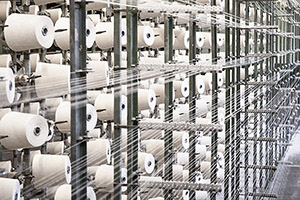Anorak in cotton half-panama in black
Prices exclude VAT, shipping is free, and orders leave the workshop within three working days.
Shop
£400.00 — ex VAT
Three-pocket anorak, made in London, with lightweight (8oz) weatherproof cotton from Lancashire, and horn buttons from Midlands.
Sizing
The anorak fits true to size. The mannequin here is as standard a 40 chest as ever there was, and so has chosen to pull size M over his head.
| XS | S | M | L | XL | |
|---|---|---|---|---|---|
| To fit chest | 36 | 38 | 40 | 42 | 44 |
| Pit-to-pit | 20 | 21 | 22 | 23 | 24 |
| Back length | 29 | 29¼ | 29½ | 29¾ | 30 |
| Sleeve from centre-back | 33¾ | 34¼ | 34¾ | 35¼ | 35¾ |
The method of sleeve construction on the jacket means the shoulders accommodate and drape smoothly over human contours of every shape and size — rendering a shoulder measurement both impossible and irrelevant.

The anorak is a lightweight, casual jacket, which has the single express purpose of being easy to pull over the head, keep out the wind and rain, and allow the body to move and breathe. It goes about this in a fairly interesting and roundabout way: simple on its face but in fact very much not.
It has a supremely high neck, the two sides of which overlap and fasten with a single button. It can be worn open, but comes into its own closed, when the neck is surrounded by weatherproof cloth. The front is cut to curve and sit away from the chin so only the bushiest of beard will sense its touch.
The buttons on the anorak are horn, are middling in colour and matte in finish. Being as each is an article hewn from nature, they look a little different from one to the next, varying in tone and hue and markings.
More buttons — two very small ones — can be found on the hood, which with the help of a hood tab (whose seam is guarded from moisture with some elementary origami) enable the wearer to adjust the fit. The hood itself is double layered, which makes the ingress of water an event unlikely even in heavy downpours.
The anorak has cuff tabs which fasten to two levels of tightness — from easy and relaxed to scaphoid-squeezingly tight, which is good when the going gets gusty.
The anorak at the fundamental level has a novel style of construction, where the side-body and the armhole are one and the same. This means you get not only a soft shoulder — and who doesn't want that — but also a vast expanse across the chest between which has been inserted an enormous pocket.
There are three pockets: the one out at the front, impossible to miss, and two smaller chest pockets inside that one. The latter are good for the safe storage of possessions most prized, while the former is best thought of as a giant bucket, for the absentminded dropping of everything else.
The bottom edge of the main pocket has a bellows strip, allowing it to expand when filled, but made in a way that means it sits flat and discreet the rest of the time.
There are vents at the side-seams which, while only a few inches in height, increase by miles the ease with which the anorak can be pulled up over the head. The wider neck-circle and the unusual body construction — which presents an open T-shape when laid flat — further facilitate an easier on-off action.
The fact the anorak is fully lined with slinky satin also assists with its donning and undonning — drastically reducing friction with whatever is being worn underneath it. The sleeves are lined likewise. In this way, the anorak is a casual jacket finished to the same standards as a finely tailored one.
Crisp, light cotton from Lancashire, this, with a water-repellent finish. It has a very high number of fine threads per inch, so is smoother, stronger, and, crucially in this case, better in the rain than your average cotton. It is highly breathable, too, and is highly adept at wicking moisture away from the body.
Makers of
The jacket is made at an outerwear factory in London: the best, many agree, in the capital. The jacket is cut by the hands of a cutter with some 30 years in the trade, and sewn by one of four seamsters whose meticulousness and pursuit of perfection would be caricature were the end results not always so good.

The cloth is supplied by a mill in east Lancashire: in a region of the country which was once red-brick cotton-mill chimneys as far as the eye could see. More or less the last of its kind, the mill has forgotten more about cotton than most will ever know — a fact borne out by the quality of its work.
The horn buttons are cut, shaped, and polished by the last horn button-maker in Britain. They continue a tradition — re-located a few hundred miles south is all — going back to the 18th century. "It is no easy task," said William Hutton in 1780, "to enumerate the infinite diversity of buttons made in Birmingham."




















